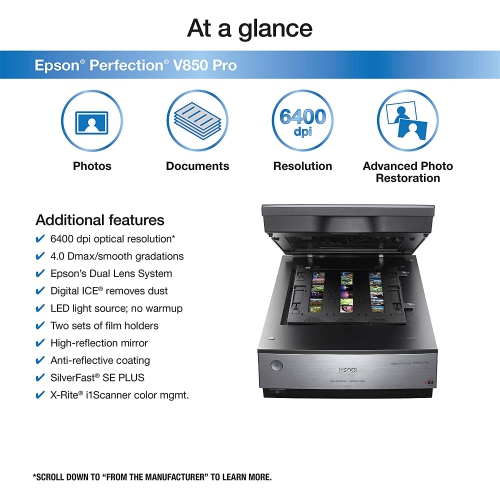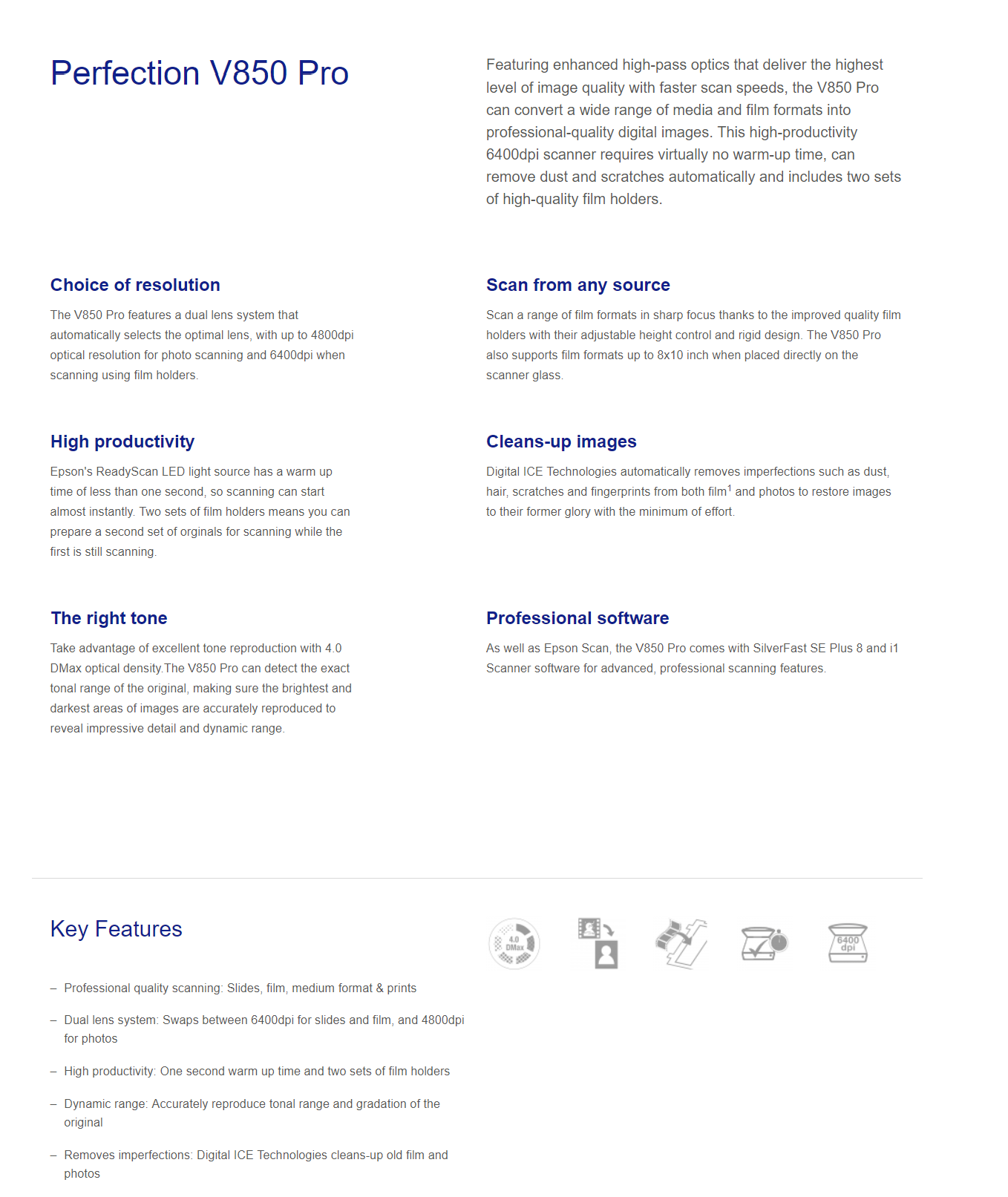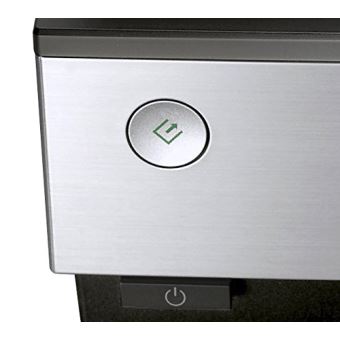- Epson Perfection V850 Pro Driver
- Epson Support V850
- Epson Perfection V850 Pro Software Mac Free
- Epson V850 Pro Manual
- Although the Epson website today, 8 Nov, states that the scanner is compatible with Mac OS 10.5.8 or later, it is not compatible with Mac OS 10.15, and Epson refused to supply a driver for Mac OS 10.15.
- Perfection V850 Pro, Perfection V850 Pro, B11B224502, 6400dpi optical film scanning resolution with Dual Lens System 4800 dpi reflective and film area guide scanning 48bit in/out Optical Density of 4.0 Dmax Matrix CCD with micro lens Anti-reflection optical coating on CCD LED light source Advanced Bundled Software MAC and PC compatible, The Colour Scanner for precise film and photo.
Scanners
Perfection V850 Pro Film and photo scanner. Professional software. As well as Epson Scan, the V850 Pro comes with SilverFast SE Plus 8 and i1 Scanner software for advanced, professional scanning features. Mac OS 10.6+, Windows 10, Windows 7, Windows 8, Windows 8.1, Windows Vista, Windows XP SP2 or higher.
Pros
- High-quality scans for photographic prints and film (including slides).
- Color-calibration target and software included.
Cons
- Color-calibration software is frustratingly hard to use.
Bottom Line
The Epson Perfection V850 Pro photo scanner offers professional-quality scanning for photographic prints and for film (positive or negative) at up to 8 by 10 inches.
Designed for professional photographers and only the most serious amateurs, the Epson Perfection V850 Pro ($949.99) is arguably the scanner of choice if you want the best possible scan quality for photosand don't mind paying for the privilege. The catch is that you can get nearly the same scan quality in an Epson model that costs about 25 percent less. So whether the V850 is worth the price depends on how much of a perfectionist you are.
The V850 is the next-generation version of the Epson Perfection V750-M Pro, which it's in the process of replacing. It's also Epson's current top-of-the-line photo scanner, one step up from the Epson Perfection V800 Photo, which is our Editors' Choice for a top-quality film scanner for prosumers.
There aren't many differences between the V850 and its less expensive near-twin. Both are flatbeds, which means they can scan photographic prints, but the real reason to get either one is for scanning film. Both models can handle anything from 35mm slides to positives or negatives as large as 8 by 10 inches. They offer a claimed 6,400-pixel-per-inch (ppi) optical resolution paired with a 4.0 Dmax rating, which translates to a promised ability to distinguish small changes in shading over the full range from white to black, particularly for shadow detail (details based on shading in dark areas). Both also offer Digital ICE hardware-based dust and scratch removal.
Where the two primarily differ is in their optics.The V850 offers what Epson calls an enhanced version of the optical system in Epson V800. The only other differences, according to Epson, are an extra set of film holders for the V850 and a slightly different set of software.
Having two sets of film holders lets you scan one set of originals while inserting the next set in a different holder, which is a useful convenience if you're scanning a lot of originals at once. Epson says you can't buy additional holders separately at this writing, although it expects them to be available at some point.
The V850's software includes a somewhat-more-capable version of LaserSoft Imaging's SilverFast scan utility than the one that comes with the Epson V800. It also adds X-Rite i1 Scanner Profiling Software for color calibration, plus a standard calibration target. Here again, both of these tools can potentially give you slightly improved scan quality. However, the improvement will generally be little enough compared with the V800 scan quality that you may not consider it worth the extra work, much less the extra cost.
Setup and Basics
Setup is typical for a USB-connected scanner, although the V850 is a little bigger and heavier than most, at 6 by 12.1 by 19.8 inches (HWD) and 14 pounds 10 ounces. Aside from X-Rite i1 and SilverFast SE Plus 8, which is the midlevel version of the full-function SilverFast Ai Studio 8, the only software that comes with the scanner is Epson's own scan utility, Epson Scan, which is what I used for most of my tests.X-Rite i1's calibration files will work with either scan utility. Unfortunately, trying to create and use a calibration file can be a frustrating experience. The first step, for example, is to choose the calibration target you're about to scan from a list in the program. However, the target that came with it didn't have any text on it that matched anything in the list, so I had to contact Epson to find out which choice to pick. There are also other steps in the process that are missing equally essential information.
Epson says it's aware of this issue and is creating documentation with the missing details, which you'll be able to download from Epson's website. However, the information should have been included with the scanner when it shipped. Without it, the V850 feels like it's missing a final polish.
Scanning
Epson Perfection V850 Pro Driver
As with the Epson V800, the key focus for the V850 is film scanning. Epson supplies two sets of four film holders designed for a variety of film formats, including 35mm slides, 35mm strips of film, medium-format film up to 6-by-20 centimeters (primarily 2.25-inch, 6-by-20 centimeters, 120, and 220 format), and 4-by-5-inch film. In addition, there's a separate Film Area Guide for film up to 8 by 10 inches. To scan, you first put the slides or film in the appropriate holder and position it on the flatbed, or position the Film Area Guide on the flatbed and place the film in the Guide.See How We Test Scanners


For my film scan tests, I used both 35mm slides and strips of film. The slide holder lets you insert up to 12 slides for scanning with a single command. The 35mm film template can hold up to three 6-frame strips of film, or 18 frames.
Scan quality was impressive. At both 2,400ppi and the maximum optical resolution of 6,400ppi, the actual resolution—meaning the ability to resolve detail—was appropriate for the setting, and dynamic range (the ability to distinguish detail based on shading over the full range from white to black) was excellent. On one of our standard test slides, with a dark tree line against a light sky, for example, the V850 did an extraordinarily good job of retaining detail in both dark and light areas.
A close look at side-by-side scans showed that the V850's scan had just a smidge better resolution than the Epson V800's scan of the same slide. However, the difference showed only in the finest details and wasminor enough to matter only to the most exacting photographers. I didn't see any difference in dynamic range between the two scanners.
The V850 also handed in excellent scans for photographic prints. That's fully predictable from its results for film, since you can get good results for prints with far lower resolution and dynamic range than you need for film. The scanner's Digital ICE also performed as expected, doing an excellent job of digitally removing dust on both prints and film, as well as removing scratches from scanned prints.

Speed counts as a plus as well, but here again, the V850 is essentially tied with the Epson V800. I timed the scanner at roughly 55 seconds for a preview scan, 38 seconds for scanning one slide at 2,400ppi, 2 minutes 24 seconds for scanning four slides, and 1:21 for scanning one slide at 6,400ppi. Scanning one frame of film at 2,400ppi took 37 seconds. Turning on Digital ICE, which requires multiple scans, bumped up the time to 2:27.
If you want top-tier scan quality, and either aren't concerned about color calibration or plan to get a program like SilverFast Ai Studio 8 that offers its own color calibration, be sure to take a close look at the Editors' Choice Epson V800. It provides very nearly the same scan quality as the Epson Perfection V850 Pro for about 25 percent less. If you're enough of a perfectionist to want the V850's smidge better resolution, however, you may well decide that the small improvement in scan quality with the V850 is worth the additional cost.
VueScan is compatible with the Epson Perfection V850 on Windows x86, Windows x64, Windows RT, Windows 10 ARM, Mac OS X and Linux.
This scanner has an infrared lamp for scanning film. VueScan's 'Filter | Infrared clean' option can be used to remove dust spots from film scans. This is similar to (and we think better than) the ICE and FARE algorithms.
Epson Support V850
It scans with visible light in the first pass and with infrared light in the second pass.
Infrared cleaning works well with all types of color negative and color slide film, including Kodachrome. However, silver-based black/white film doesn't work with infrared cleaning because the silver particles look the same in visible light and infrared light.
If you're using Windows and you've installed a Epson driver, VueScan's built-in drivers won't conflict with this. If you haven't installed a Windows driver for this scanner, VueScan will automatically install a driver.
Epson Perfection V850 Pro Software Mac Free
You can use this scanner on Mac OS X and Linux without installing any other software.
Epson V850 Pro Manual
Epson sold this scanner in some countries as the Perfection V800 / GT-X980.